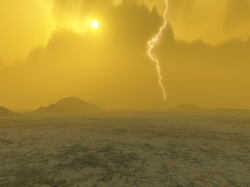
I haven’t posted anything yet about our other neighboring planet, Venus, mostly because the currently active mission exploring it, the European Space Agency’s Venus Express orbiter, hasn’t been updating much with new images since I’ve begun this site. Still, Venus deserves some attention, so here’s a quick byte of Venus info.

Possibly the most inhospitable of planets in our solar system, the “evening star” Venus is permanently enshrouded by thick yellowish-beige clouds. In order to see any cloud structure at all, images must be made in other wavelengths of light….infrared, or ultraviolet (above). In these wavelengths invisible to our eyes, the swirling structures of Venus’ atmosphere can be made out. And what an atmosphere it is! An example of greenhouse effect to the nth degree, our neighboring Venus is a virtual oven…its scorched, rocky surface baked by 800ºF + temperatures beneath the crushing weight of its own incredibly dense atmosphere, standing “sea level” on Venus would be like being hundreds of feet underwater, just in terms of pressure per square inch. And if the heat and pressure weren’t enough, the skies are full of clouds made of corrosive sulphuric acid as well, lit by bolts of lightning and and whipped by incredible planet-wide winds clocked in the hundreds of miles per hour. All Earth-based probes that landed there (such as the Soviet Venera-13, seen below) only lasted moments on the surface before they succumbed to Venus’ destructive environment.

Venus is, quite literally, a hellish place. And, oddly enough, it is the planet that most resembles Earth, in terms of size and composition. It’s an example of how being just that much closer to the sun, without the benefit of any carbon-dioxide processing life forms like Earth has developed, drastically changes an entire planet. I may not be the most militant tree-hugger but I do realize the unmistakable effect plant life has on our world. Venus shows us what Earth could have been. Quite easily. And very well could still become. And that’s why the ESA’s Venus Express mission is so important.
More images from the Venus Express mission here.
Image credit: ESA/MPS/DLR/IDA. Venera-13 image remapped by Don P. Mitchell.
It’s not the sun that has caused Venus to have a hellish surface, that’s a misconception. Venus is within the habitable zone, as far as Earth life goes. Earth could be anywhere from around Venus to a little beyond Mars and still be more than capable of life. Maybe not life as we know it, and certainly there would be areas where you wouldn’t want to live just as there are today (the poles for example). It’s a misconception that Earth is somehow magically in the right spot to develop life. More like current life is a result of the spot, but life would still be possible, even intelligent life.
There speculation that Venus may have even been more Earth-like at one point and may have even had oceans. Venus is, as you mentioned, very similar to Earth in terms of size and mass. Earth’s twin. The biggest differences are that Venus has no magnetosphere. Mars doesn’t really have one either, but they are common to the other planets. Even Ganymede has a magnetosphere. Venus rotates very slowly and retrograde. It’s also tilted on its side. These are responsible for the hellish surface conditions, not the distance to the sun.
Venus and Earth are extremely close in space. When their orbits catch up, Venus is only 100 times the distance from the Earth to the moon away. Mercury is about 2x this distance and the sun is 4x this distance. The sun probably has a tidal effect on Venus, but not enough to tidally lock it. Again, it’s rotating retrograde and it’s tilt is probably partially the blame. Whether this had an effect on the magnetosphere, nobody knows. If it had the same tilt as Earth, and a similar tilt/rotation, the greenhouse effect probably wouldn’t be that bad. In all likelihood, Venus had an ancient cosmic collision that went really bad. So did Mars. Despite what scientists say, Mars’ probably happened in human history even. Otherwise those planet-wide dust storms would have buried the evidence by now.
LikeLike